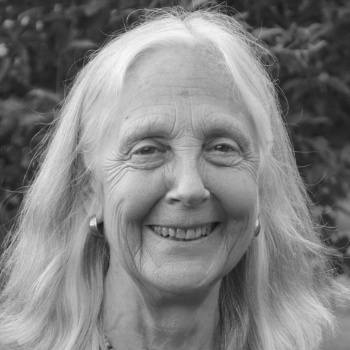An excerpt from Lasell Bartlett’s just published book, Getting Along with Rusty: Horses, Healing and Therapeutic Riding

I was hired to help a dozen teenage girls learn to get along. They were also being helped by Ollie, who was learning to be a therapy horse. Dappled gray and huge and moderately clueless about turning and stopping, Ollie knew more about socializing than the teenagers did. That was his best attribute. He was an easygoing fellow, happy to hang out with anyone who took him to graze on the lawn, happy to be led around in the arena, circling cones and stepping over ground poles.
Those teenagers loved him because some of his behaviors could be interpreted as affection and liking the girls, and that meant a lot to them. They had been failed in most relationships—at home, at school, in their community. They knew little of safety and trust, of friendship, of getting along. And there was Ollie, humongous and mellow, ready to come in close and nuzzle you. He was probably looking for treats, but the girls didn’t know that. They keyed in on being approached by this monstrously large, friendly animal. Ollie provided reparative relationship moments for these youngsters. A little fear (who wouldn’t be a little scared of someone that big?) was dissolved by a lot of gentle attention. Plus, this big Ollie animal would go where they asked him to go. Someone was listening to their requests.
Many of the girls who loved Ollie wanted to ride him. Only one wanted to ride him more than once. After noticing this pattern of one ride being enough, I became curious, and realized I needed to ride Ollie myself. I needed to know kinesthetically what was happening while riding him.
Riding Ollie was unpleasant and challenged my balance. I hadn’t known the consequence to a human body of sitting on this very awkward, broad-backed, gaited horse who had little understanding of what’s expected when being ridden. Ollie’s habit was to walk fast in a straight line. He traveled on autopilot and that quality was complicated by something that felt like a hitch in his walk.
After I got off, I asked one of the girls to lead him while I observed. Ollie did a strange thing. When moving in an arc, most horses will lead with the inside front leg stepping slightly in the direction of the arc. This is how horses easily maintain balance while turning. Ollie did something else. He stepped toward the outside of the arc with his inside front foot. No wonder he felt all wiggly-wobbly to ride. He was unbalanced and that made him feel insecure. His lack of balance also made the rider—way up high on his back—feel unbalanced and insecure. Imagine riding an athletic, inebriated walrus. The memory makes my stomach clench.
Chip, on the other hand, was a therapy horse that everyone wanted to ride again and again. He was ancient in horse years—so old he lived on soaked mash three times a day because his teeth were gone. He liked to gum hay and was smart enough to drop it from his mouth rather than try to swallow the big, wet wads. He was predictably a slow mover and his preferred speed was a full stop. He was shorter than many horses, so the distance to the ground was less frightening for those who rode him. The problem was he was so old that he was officially retired from riding. His back had sunk into the conformation we call swaybacked, and we were unsure if he was comfortable carrying a saddle and rider.
It was a challenge for us staff to say no to the girls who wanted to ride, and only wanted to ride Chip. Saying no often triggered their protest in the form of raging tantrums targeted at us adults. In face of the conflict between protecting Chip and protecting ourselves, we usually protected Chip. As it can be with horse people, we often choose to take care of our horses instead of ourselves.
Sadly, these girls, as much as they were attracted to the horses, hadn’t developed those empathy parts, the parts that can care more about the welfare of another than one’s own yearnings. I understood their wanting to be close to Chip. He was a safe being for them. He was disabled by age. They were disabled by social circumstances and all the developmental delays and losses that come from abuse and neglect in families and schools. Chip was an ally. Chip was a compadre. Chip was a confidant. Chip stuck around when a trickle of tears was allowed in the privacy of leaning into the mane of a just-right-sized horse. Being with Chip was the first time it felt safe to be vulnerable. Being with Chip was a gateway to hope for something more.
 Getting Along with Rusty
Getting Along with Rusty
Horses, Healing and Therapeutic Riding (Mostly a Memoir)
by Lasell Jaretzki Bartlett, MSW (aka Kavita) – lasellbartlett.com
Lilith House Press (August 19+20, 2023), 254 pages
Available through your favorite bookstore or online as hardcover, paperback and Kindle on Amazon or via Barnes & Noble – Scribd – Thriftbooks, etc.
ASIN: B0CG7FT8SC
Hardcover ISBN-13 : 979-8985810158
Paperback ISBN-13 : 979-8985810141
Related article
- Getting Along with Rusty: Horses, Healing and Therapeutic Riding – A review by Nayana





Comments are closed.